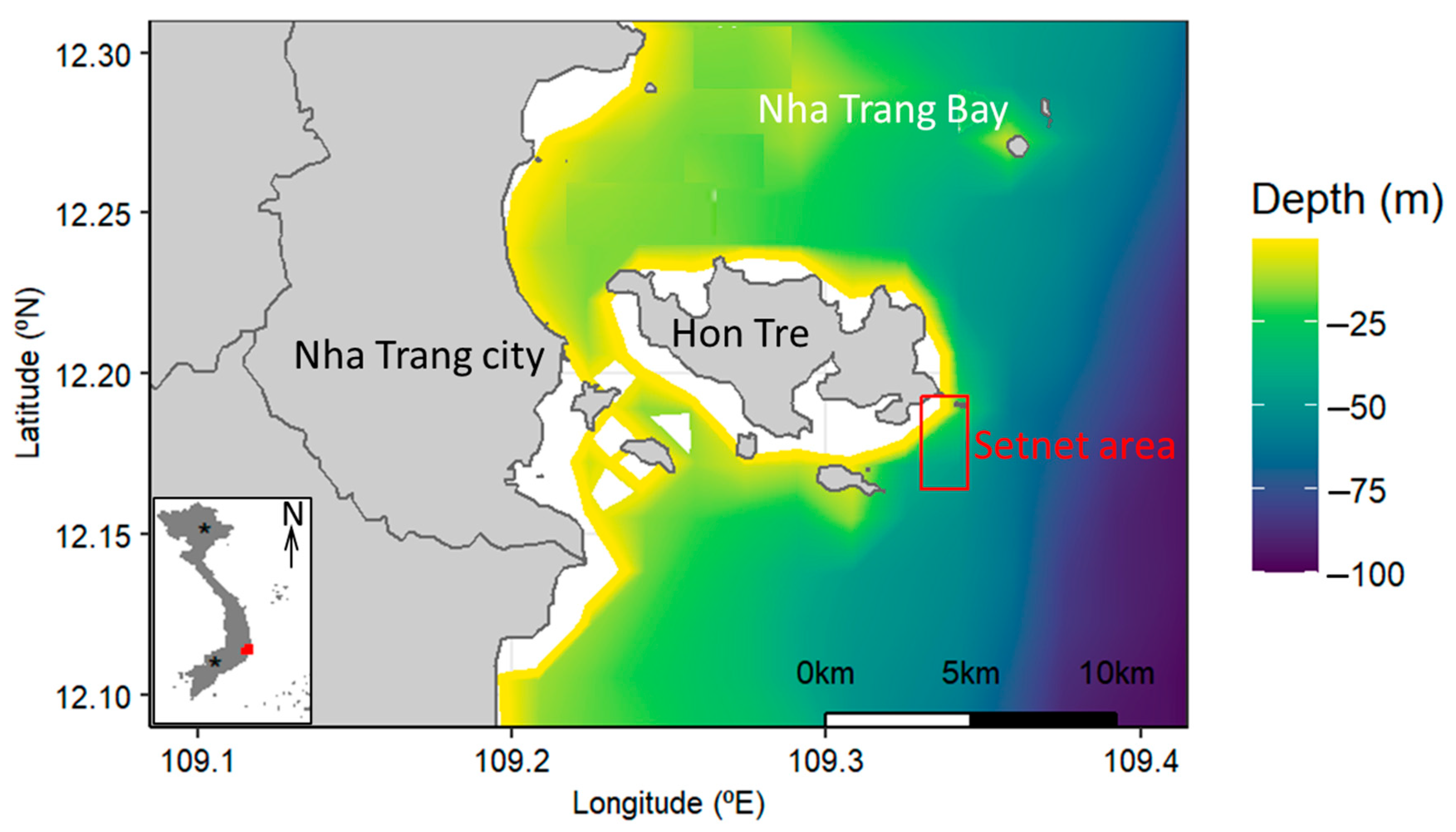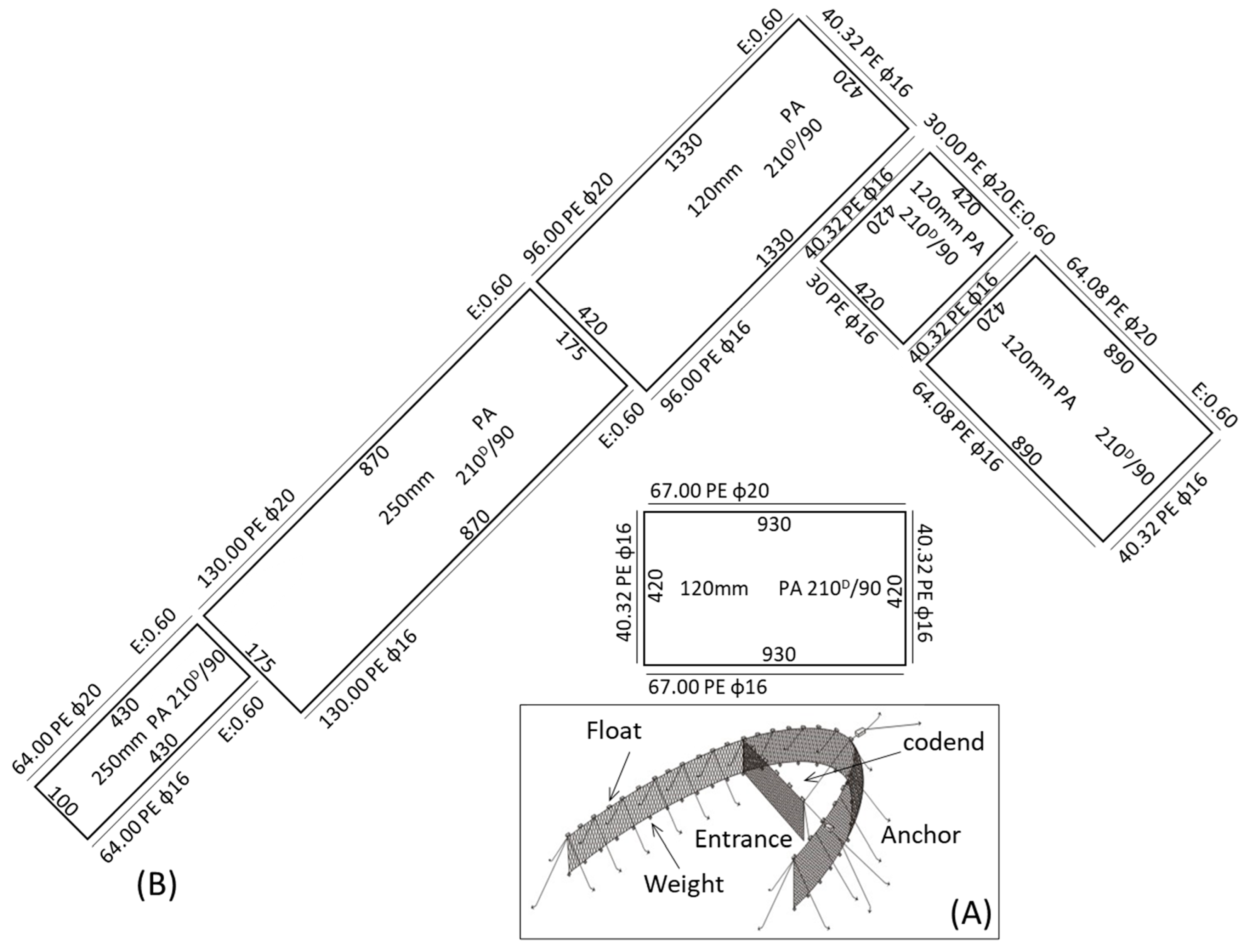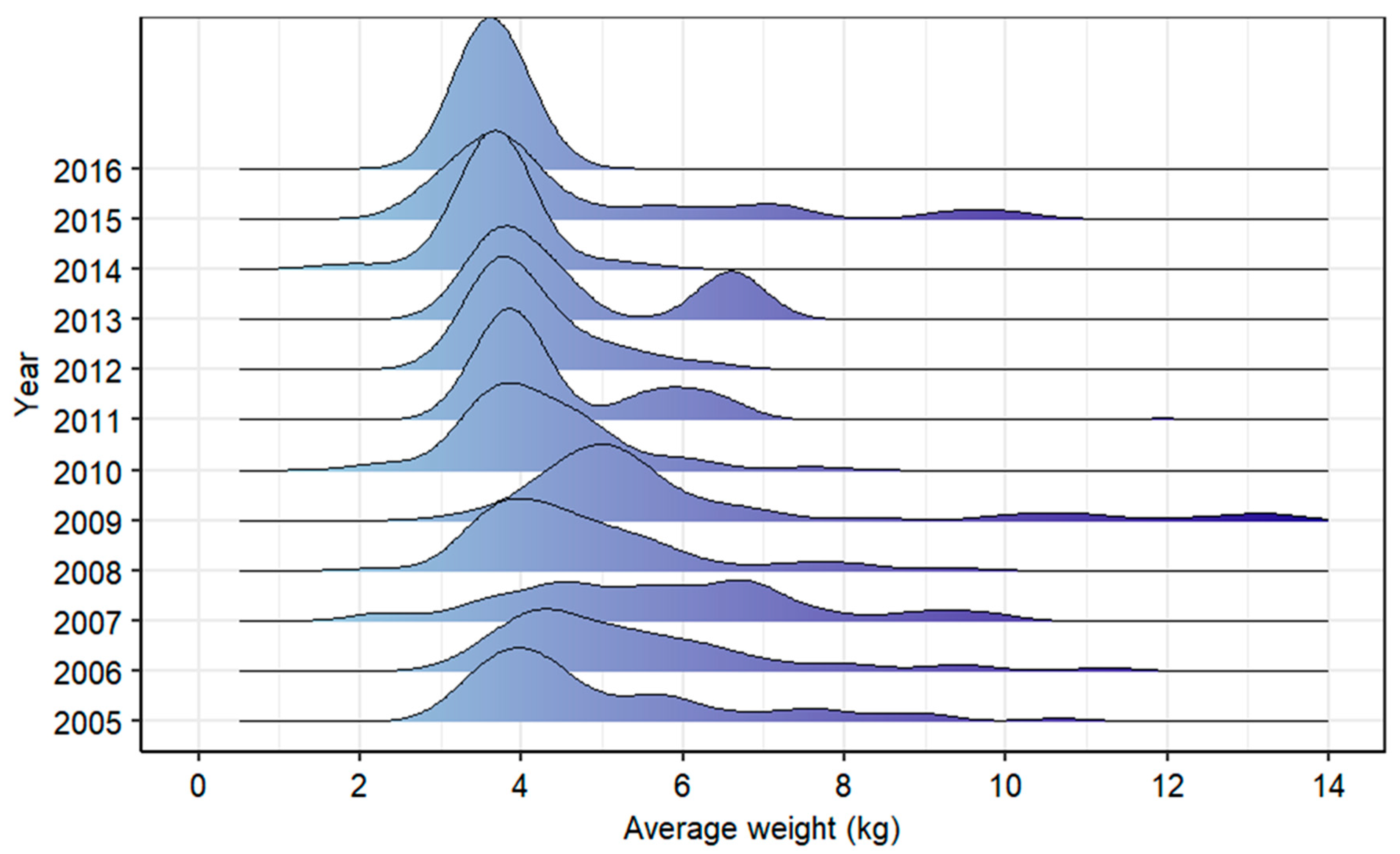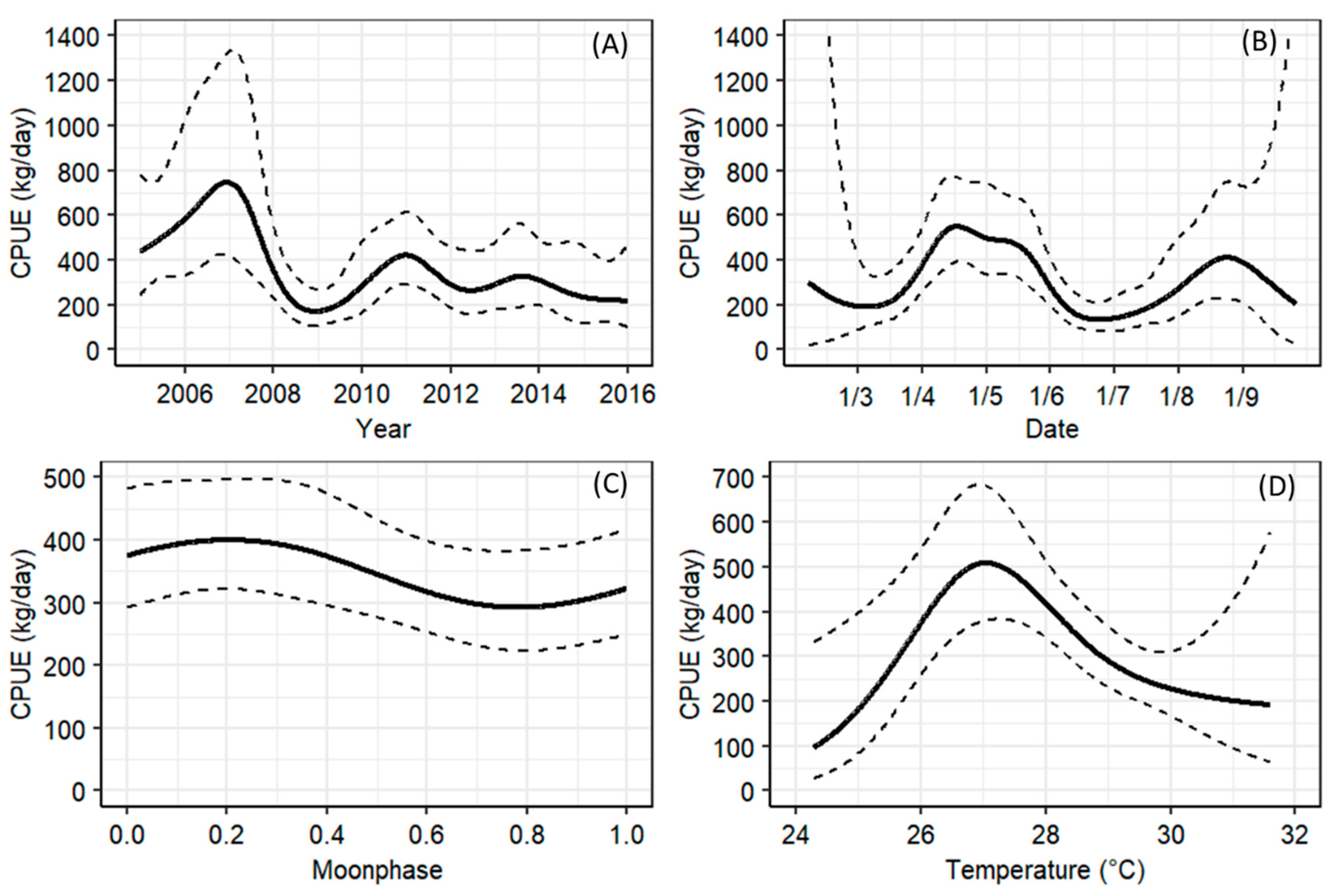The Effect of Temporal and Environmental Conditions on Catch Rates of the Narrow-Barred Spanish Mackerel Setnet Fishery in Khanh Hoa Province, Vietnam
Abstract
1. Introduction
2. Materials and Methods
2.1. Study Site
2.2. Data Collection
2.3. Statistical Analysis
3. Results
4. Discussion
5. Conclusions
Author Contributions
Funding
Institutional Review Board Statement
Data Availability Statement
Acknowledgments
Conflicts of Interest
Appendix A

References
- He, P.; Chopin, F.; Suuronen, P.; Ferro, R.S.T.; Lansley, J. Classification and Illustrated Definition of Fishing Gears; FAO Fisheries and Aquaculture Technical Paper No. 672.; FAO: Rome, Italy, 2021. [Google Scholar] [CrossRef]
- Nguyen, K.Q.; Nguyena, V.Y. Changing of Sea Surface Temperature Affects Catch of Spanish Mackerel Scomberomorus commerson in the Set-Net Fishery. Fish. Aquac. J. 2017, 8, 1–7. [Google Scholar] [CrossRef]
- Liu, J.M.; So, P.Y. Analysis of the positioning factors affecting the sustainable fishing gear-Set net. Fish. Res. 2024, 269, 106865. [Google Scholar] [CrossRef]
- Munprasit, A. Cooperative setnet fishing technology for sustainable coastal fisheries management in southeast Asia. Fish People 2010, 8, 21–24. [Google Scholar]
- Munprasit, A.; Amornpiyakrit, T.; Yingyuad, W.; Arimoto, T. Enhancing community-based management through setnet fisheries: A regional fishery collaborative venture. Fish People 2012, 10, 2–11. [Google Scholar]
- Lu, H.; Lee, H. Changes in the fish species composition in the coastal zones of the Kuroshio Current and China Coastal Current during periods of climate change: Observations from the set-net fishery (1993–2011). Fish. Res. 2014, 155, 103–113. [Google Scholar] [CrossRef]
- Nguyen, L.T.; Nguyen, K.Q.; Nguyen, T.P. Experimental mixed gillnets improve catches of narrow-barred Spanish mackerel (Scomberomorus commerson). Fishes 2023, 8, 210. [Google Scholar] [CrossRef]
- Nguyen, K.Q.; Tran, P.D.; Nguyen, L.T.; To, P.V.; Morris, C.J. Use of light-emitting diode (LED) lamps in combination with metal halide (MH) lamps reduce fuel consumption in the Vietnamese purse seine fishery. Aquac. Fish. 2021, 6, 432–440. [Google Scholar] [CrossRef]
- Nguyen, K.Q.; Do, M.D.; Phan, H.T.; Nguyen, L.T.; To, P.V.; Vu, N.K.; Tran, P.D. Catch composition and codend selectivity of inshore trawl fishery with the legal minimum mesh size. Reg. Stud. Mar. Sci. 2021, 47, 101977. [Google Scholar] [CrossRef]
- Yoshida, T.; Sugino, K.; Nishikawa, H. Classification of set-net fish catch volumes in Iwate Prefecture, Japan using machine learning with water temperature and current distribution images at migration depth. Reg. Stud. Mar. Sci. 2024, 73, 103480. [Google Scholar] [CrossRef]
- Frid, O.; Belmaker, J. Catch dynamics of set net fisheries in Israel. Fish. Res. 2019, 213, 1–11. [Google Scholar] [CrossRef]
- Nguyen, L.T.; Tran, P.D.; Nguyen, K.Q. An effectiveness of artificial coral reefs in the restoration of marine living resources. Reg. Stud. Mar. Sci. 2022, 49, 102143. [Google Scholar] [CrossRef]
- VASEP. Vietnam’s Seafood Exports in 2023. 2024. Available online: https://vasep.com.vn/san-pham-xuat-khau/infographic/infographic-xuat-khau-thuy-san-cua-viet-nam-nam-2023-29790.html (accessed on 22 January 2024).
- Nguyen, L.T.; Nguyen, K.Q. Effects of jig location and soak time on catch rates of a novel fishing gear design of squid longline fisheries. Reg. Stud. Mar. Sci. 2022, 52, 102312. [Google Scholar] [CrossRef]
- Le, T.P.; Ho, B.D.; Nguyen, H.P.; Tran, T.H.H.; Vo, V.Q. The Pelagic weir fishery in Nha Trang city, Vietnam. Collect. Mar. Res. Work. 2003, 8, 207–214, (In Vietnamese with English abstract). [Google Scholar]
- Tran, D.P.; Nguyen, Y.V. Study on chamber innovation to enhance the quantity of set-net fisheries in Khanh Hoa province. J. Fish. Sci. Technol. 2017, 2017, 52–59. [Google Scholar]
- Vo, D. Some characteristics of Spainish mackerel Scomboromorus commerson Lacepède 1800 in Hon Mun Marine Protect Area. J. Sci. 2007, 39, 19–24, (In Vietnamese with English abstract). [Google Scholar]
- FAO. Scomberomorus commerson Lacepède, 1800; Fisheries and Aquaculture Division: Rome, Italy, 2023; Available online: https://www.fao.org/fishery/en/aqspecies/3280/en (accessed on 21 April 2025).
- Fishbase. Narrow-barred Spanish Mackerel. 2025. Available online: https://www.fishbase.se/summary/scomberomorus-commerson (accessed on 21 April 2025).
- Grandcourt, E.M.; Al Abdessalaam, T.Z.; Francis, F.; Al Shamsi, A.T. Preliminary assessment of the biology and fishery for the narrow-barred Spanish mackerel, Scomberomorus commerson (Lacépède, 1800), in the southern Arabian Gulf. Fish. Res. 2005, 76, 277–290. [Google Scholar] [CrossRef]
- Pouladi, M.; Paighambari, S.Y.; Broadhurst, M.K.; Millar, R.B.; Eighani, M. Effects of season and mesh size on the selection of narrow-barred Spanish mackerel, Scomberomorus commerson in the Persian Gulf artisanal gillnet fishery. J. Mar. Biol. Assoc. United Kingd. 2020, 100, 1321–1325. [Google Scholar] [CrossRef]
- Niamaimandi, N.; Kaymaram, F.; Hoolihan, J.P.; Mohammadi, G.H.; Fatemi, S.M.R. Population dynamics parameters of narrow-barred Spanish mackerel, Scomberomorus commerson (Lacèpéde, 1800), from commercial catch in the northern Persian Gulf. Glob. Ecol. Conserv. 2015, 4, 666–672. [Google Scholar] [CrossRef]
- Chen, L.C.; Weing, J.-S.; Naimullah, M.; Hsiao, P.-Y.; Tseng, C.-T.; Lan, K.-Y.; Chuang, C.-C. Distribution and catch rate characteristics of narrow-barred Spanish mackerel (Scomberomorus commerson) in relation to oceanographic factors in the waters around Taiwan. Front. Mar. Sci. 2021, 8, 1–14. [Google Scholar] [CrossRef]
- Cheung, W.W.L.; Lam, V.W.Y.; Sarmiento, J.L.; Kearney, K.; Watson, R.; Pauly, D. Projecting global marine biodiversity impacts under climate change scenarios. Fish Fish. 2009, 10, 235–251. [Google Scholar] [CrossRef]
- Choo, H. Correlation between water temperature and catch at a set net in yeosu bay, korea. Fish. Aquat. Sci. 2021, 24, 41–52. [Google Scholar] [CrossRef]
- Liu, Q.; Zhang, Q. Analysis on long-term change of sea surface temperature in the China Seas. J. Ocean Univ. China 2013, 12, 295–300. [Google Scholar] [CrossRef]
- Li, M.; Xu, Y.; Sun, M.; Li, J.; Zhou, X.; Chen, Z.; Zhang, K. Impacts of Strong ENSO Events on Fish Communities in an Overexploited Ecosystem in the South China Sea. Biology 2023, 12, 946. [Google Scholar] [CrossRef]
- Liu, Z.; Li, J.; Zhang, J.; Chen, Z.; Zhang, K. Climate Variability and Fish Community Dynamics: Impacts of La Niña Events on the Continental Shelf of the Northern South China Sea. J. Mar. Sci. Eng. 2025, 13, 474. [Google Scholar] [CrossRef]
- Kamaruzzaman, Y.N.; Mustapha, M.A.; Ghaffar, M.A. Impacts of Sea Temperature Rise on Rastrelliger kanagurta Potential Fishing Grounds in the Exclusive Economic Zone (EEZ) off South China Sea. Sains Malays. 2021, 50, 3467–3479. [Google Scholar] [CrossRef]
- Nguyen, K.Q.; Nguyen, B.V.; Phan, H.T.; Nguyen, L.T.; To, P.V.; Tran, H.V. A comparison of catch efficiency and bycatch reduction of tuna pole-and-line fisheries using Japan tuna hook (JT-hook) and circle-shaped hook (C-hook). Mar. Freshw. Res. 2022, 73, 662–677. [Google Scholar] [CrossRef]
- Van Long, N.; Tuan, V.S.; Hoang, P.K.; Tuyen, H.T.; Khang, N.A.; Quang, T.M.; Hong, P.T.K. Coral reefs in Van Phong bay, Khanh Hoa province: Status and management perspectives. Mar. Res. Sel. 2014, 20, 121–134. [Google Scholar]
- Beck, N.; Jackman, S. Beyond linearity by default: Generalized additive models. Am. J. Pol. Sci. 1998, 42, 596–627. [Google Scholar] [CrossRef]
- Cook, R.D. Influential observations in linear regression. J. Am. Stat. Assoc. 1979, 74, 169–174. [Google Scholar] [CrossRef]
- Luo, D.; Ganesh, S.; Koolaard, J. Package ‘Predictmeans’: Predicted Means for Linear and Semi Parametric Models. 2022. Available online: https://CRAN.R-project.org/package=predictmeans (accessed on 21 April 2025).
- R Development Core Team. R: A Language and Environment for Statistical Computing; R Foundation for Statistical Computing: Vienna, Austria, 2021; Available online: http://www.R-project.org (accessed on 21 April 2021).
- Fardilah, M.F.F.; Simbolon, D.; Sondita, M.F.A.; Sari, T.E.Y.; Setiawan, H. Spatial-temporal distribution of narrow-barred Spanish mackerel (Scomberomorus commerson) fishing grounds in Riau archipelago waters, Indonesia. Mar. Fish. J. Mar. Fish. Technol. Manag. 2024, 15, 6982. [Google Scholar] [CrossRef]
- Nguyen, K.Q.; Tran, P.D.; Le, P.V.; Nguyen, L.T.; To, P.V. Advancing fishing technology education and research: A 65-year legacy at Nha. J. Fish. 2024, 12, 123501. [Google Scholar] [CrossRef]
- Pauly, D.; Liang, C. The fisheries of the South China Sea: Major trends since 1950. Mar. Policy. 2020, 121, 103584. [Google Scholar] [CrossRef]
- Nguyen, K.Q. Length-weight and length-length relationships of 16 marine fish species in Vietnam. Ocean Coast. Res. 2024, 72, e24031. [Google Scholar] [CrossRef]
- Nghĩa, N.V.; Hà, V.V.; Huy, P.Q.; Minh, N.H.; Thành, N.C. A Comprehensive Assessment of Marine Resources in the Vietnamese Waters from 2016 to 2020; Technical report; Research Institute for Marine Fisheries: Hai Phong, Vietnam, 2020; 229p. [Google Scholar]
- Mildenberger, T.K.; Taylor, M.H.; Wolff, M. TropFishR: An R package for fisheries analysis with length-frequency data. Methods Ecol. Evol. 2017, 8, 1520–1527. [Google Scholar] [CrossRef]
- An, N.T.; Mầu, L.Đ.; Pavlov, D.C. Evaluation of Hydro-Dynamical Processes for Ecosystem Studies in Nha Trang Bay, Vietnam, in Collection of Reports of the National Conference “East Sea—2007”. 2007. pp. 379–390. Available online: http://tvhdh.vnio.org.vn:8080/dspace/bitstream/123456789/19443/1/379-390_NguyenTacAn%20va%20cs.pdf (accessed on 21 April 2025).
- Kim, J.Y.; Kang, Y.S.; Oh, H.J.; Suh, Y.S.; Hwang, J.D. Spatial distribution of early life stages of anchovy (Engraulis japonicus) and hairtail (Trichiurus lepturus) and their relationship with oceanographic features of the East China Sea during the 1997–1998 El Niño Event. Estuar. Coast. Shelf Sci. 2005, 63, 13–21. [Google Scholar] [CrossRef]
- Gray, C.A.; Johnson, D.D.; Broadhurst, M.K.; Young, D.J. Seasonal, spatial and gear-related influences on relationships between retained and discarded catches in a multi-species gillnet fishery. Fish. Res. 2005, 75, 56–72. [Google Scholar] [CrossRef]
- Ekwurzel, B.; Boneham, J.; Dalton, M.W.; Heede, R.; Mera, R.J.; Allen, M.R.; Frumhoff, P.C. The rise in global atmospheric CO2, surface temperature, and sea level from emissions traced to major carbon producers. Clim. Change 2017, 144, 579–590. [Google Scholar] [CrossRef]
- Zhou, L.T.; Tam, C.Y.; Zhou, W.; Chan, J.C.L. Influence of South China Sea SST and the ENSO on winter rainfall over South China. Adv. Atmos. Sci. 2010, 27, 832–844. [Google Scholar] [CrossRef]
- Nguyen, L.T.; Nguyen, T.P.; Do, T.V.; Nguyen, K.Q. Light-emitting diode (LED) lights reduce the fuel consumption and maintain the catch rate of stick-held falling net fisheries. Reg. Stud. Mar. Sci. 2022, 55, 102542. [Google Scholar] [CrossRef]
- Wang, X.; Zhaning, J.; Zhoa, X.; Chen, Z.; Ying, Y.; Li, Z.; Xu, D.; Liu, Z.; Zhou, M. Vertical distribution and diel migration of mesopelagic fishes on the northern slope of the South China sea. Deep Sea Res. Part II Top. Stud. Oceanogr. 2019, 167, 128–141. [Google Scholar] [CrossRef]
- Kim, T.-K.; Kim, H.-S.; Lee, J.-H.; Kim, S. A study on the selectivity of grid type escape device for the reduction of small size of fish in set net. J. Korean Soc. Fish. Technol. 2013, 49, 188–199. [Google Scholar] [CrossRef]
- Vu, N.K.; Nguyen, K.Q. A comparison of catch Rates of C-hooks and J-hooks in the hook-and-line tuna fishery. Egypt. J. Aquat. Biol. Fish. 2025, 29, 1205–1219. [Google Scholar] [CrossRef]
- Tosunoglu, Z.; Ceyhan, T.; Gulec, O.; Duzbastilar, F.O.; Kaykac, M.H.; Aydin, C.; Metin, G. Effects of lunar phases and other variables on CPUE of european pilchard, sardina pilchardus, caught by purse seine in the eastern mediterranean. Turk. J. Fish. Aquat. Sci. 2021, 21, 283–290. [Google Scholar] [CrossRef]
- Nguyen, T.K.N. Law on Fisheries (Law No. 18/2017/QH14); National Political Publishing House: Ha Noi, Vietnam, 2017. [Google Scholar]
- Nguyen, V.Y. Research on Improving the Setnet Structures in Nha Trang City; Project Report, TR2012-13-28; Institetute of Marine Science and Fishing Technology of Nha Trang University: Nha Trang, Vietnam, 2014; 90p. [Google Scholar]
- Thụy, T.T.; Nga, P.T.T. Developing Khanh Hoa beach and island tourism. HCMUE J. Sci. 2019, 52, 56–67. [Google Scholar]





| Year | # of Fishing Days | Total Catch (kg) | Month | # of Fishing Days | Total Catch (kg) |
|---|---|---|---|---|---|
| 2005 | 53 | 23,456.9 | 2 | 6 | 1304.5 |
| 2006 | 48 | 26,726.0 | 3 | 87 | 20,181.5 |
| 2007 | 21 | 17,689.9 | 4 | 177 | 93,758.8 |
| 2008 | 71 | 26,054.7 | 5 | 145 | 62,719.2 |
| 2009 | 70 | 10,832.3 | 6 | 102 | 14,704.7 |
| 2010 | 50 | 16,032.0 | 7 | 64 | 12,235.3 |
| 2011 | 114 | 44,671.9 | 8 | 60 | 23,170.5 |
| 2012 | 69 | 25,205.9 | 9 | 12 | 3769.9 |
| 2013 | 36 | 2859.2 | Sum | 653 | 231,844 |
| 2014 | 66 | 28,619.3 | |||
| 2015 | 27 | 2698.2 | |||
| 2016 | 28 | 6998.3 | |||
| Sum | 653 | 231,844.5 |
| Common Name | Species Name | Total Catch (ton) | Percent (%) |
|---|---|---|---|
| Target species (retained) | |||
| Narrow-barred Spanish mackerel | Scomberomorus commerson | 231.84 | 60.4 |
| Incidental catch (retained) | |||
| Flat needlefish | Ablennes hians | 0.89 | 0.2 |
| Unicorn leatherjacket filefish | Aluterus monoceros | 2.43 | 0.6 |
| Frigate tuna | Auxis thazard thazard | 5.61 | 1.5 |
| Limpid-wing flyingfish | Cheilopogon unicolor | 3.45 | 0.9 |
| Redtail scad | Decapterus kurroides | 8.98 | 2.3 |
| Shortfin scad | Decapterus macrosoma | 7.2 | 1.9 |
| Japanese scad | Decapterus maruadsi | 4.78 | 1.2 |
| Black-spotted grouper | Epinephelus epistictus | 2.13 | 0.6 |
| Kawakawa | Euthynnus affinis | 1.46 | 0.4 |
| Skipjack tuna | Katsuwonus pelamis | 39.9 | 10.4 |
| Squid | Loligo chinensis | 3.46 | 0.9 |
| Red snapper | Lutjanus sanguineus | 4.21 | 1.1 |
| Torpedo scad | Megalaspis cordyla | 6.27 | 1.6 |
| Moontail bullseye | Priacanthus hamrur | 7.82 | 2.0 |
| Bigeye scad | Selar crumenophthalmus | 6.73 | 1.8 |
| Bigfin reef squid | Sepioteuthis lessoniana | 1.84 | 0.5 |
| Mottled spinefoot | Siganus fuscescens | 5.32 | 1.4 |
| Spotted mackerel | Somber autralasicus | 17.2 | 4.5 |
| Bigeye barracuda | Sphyraena forsteri | 3.7 | 1.0 |
| Swordfish | Xiphias gladius | 18.62 | 4.8 |
| Other species | 0.21 | 0.1 | |
| Sum | 384.05 | 100 |
| GCV | Adjusted R2 | Deviance Explained | AIC | Predictors | edf | Ref.df | F | p |
|---|---|---|---|---|---|---|---|---|
| 1.816 | 0.62 | 53.2% | 8777.755 | s(Year) | 9.851 | 10 | 6.805 | <0.001 |
| s(DoY) | 7.438 | 9 | 7.364 | <0.001 | ||||
| s(Moon phase) | 1.309 | 2 | 1.599 | 0.012 | ||||
| s(Temperature) | 2.883 | 3 | 4.985 | 0.002 |
Disclaimer/Publisher’s Note: The statements, opinions and data contained in all publications are solely those of the individual author(s) and contributor(s) and not of MDPI and/or the editor(s). MDPI and/or the editor(s) disclaim responsibility for any injury to people or property resulting from any ideas, methods, instructions or products referred to in the content. |
© 2025 by the authors. Licensee MDPI, Basel, Switzerland. This article is an open access article distributed under the terms and conditions of the Creative Commons Attribution (CC BY) license (https://creativecommons.org/licenses/by/4.0/).
Share and Cite
Vu, N.K.; Nguyen, K.Q. The Effect of Temporal and Environmental Conditions on Catch Rates of the Narrow-Barred Spanish Mackerel Setnet Fishery in Khanh Hoa Province, Vietnam. Fishes 2025, 10, 257. https://doi.org/10.3390/fishes10060257
Vu NK, Nguyen KQ. The Effect of Temporal and Environmental Conditions on Catch Rates of the Narrow-Barred Spanish Mackerel Setnet Fishery in Khanh Hoa Province, Vietnam. Fishes. 2025; 10(6):257. https://doi.org/10.3390/fishes10060257
Chicago/Turabian StyleVu, Nghiep Ke, and Khanh Quoc Nguyen. 2025. "The Effect of Temporal and Environmental Conditions on Catch Rates of the Narrow-Barred Spanish Mackerel Setnet Fishery in Khanh Hoa Province, Vietnam" Fishes 10, no. 6: 257. https://doi.org/10.3390/fishes10060257
APA StyleVu, N. K., & Nguyen, K. Q. (2025). The Effect of Temporal and Environmental Conditions on Catch Rates of the Narrow-Barred Spanish Mackerel Setnet Fishery in Khanh Hoa Province, Vietnam. Fishes, 10(6), 257. https://doi.org/10.3390/fishes10060257






